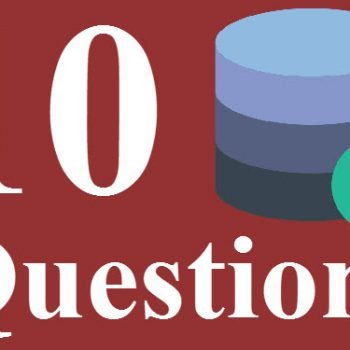One of the reasons, I love my job is that I get to work with the latest technology and also get to speed up the client’s computer. Recently one of my clients upgraded their SQL Server to the latest version SQL Server 2019. After the upgrade, they expected that the performance of SQL Server will increase but honestly, they did not see any difference at all. They reached out to me and we started to work on Comprehensive Database Performance Health Check. While working together, I had a pleasure to demonstrate to customers a Simple Example of Batch Mode in RowStore.

Batch Mode in RowStore
SQL Server 2019 now supports Batch Mode in RowStore, which was previously only possible via few hacks or using a column store index. However, in SQL Server 2019, now Batch Mode is available for a query without even having a column store index.
The biggest difference between the newer batch mode and traditional row mode operation is the performance of the query with aggregation. The traditional Row Execution Mode processes are performed on a row-by-row basis, whereas the batch execution mode processes data by grouping them into batches. The typical batch is of several hundreds of rows. Usually, the number rows per batches are between 64 to 912 rows but again, this number can easily change if Microsoft releases a new patch or updates to the algorithm.
Let us see a simple example of we can get the batch mode in rowstore.
Simple Example
First I will be building a table with lots of data. Please note that this demo needs really lots of rows in your table otherwise, it will find the traditional use of row mode efficient.
In the following example, I am using an AdventureWorks database, but you can use any database with lots of rows.
USE AdventureWorks2017 GO -- Create New Table CREATE TABLE [dbo].[MySalesOrderDetail]( [SalesOrderID] [int] NOT NULL, [SalesOrderDetailID] [int] NOT NULL, [CarrierTrackingNumber] [nvarchar](25) NULL, [OrderQty] [smallint] NOT NULL, [ProductID] [int] NOT NULL, [SpecialOfferID] [int] NOT NULL, [UnitPrice] [money] NOT NULL, [UnitPriceDiscount] [money] NOT NULL, [LineTotal] [numeric](38, 6) NOT NULL, [rowguid] [uniqueidentifier] NOT NULL, [ModifiedDate] [datetime] NOT NULL ) ON [PRIMARY] GO -- Create clustered index CREATE CLUSTERED INDEX [CL_MySalesOrderDetail] ON [dbo].[MySalesOrderDetail] ( [SalesOrderDetailID]) GO -- Create Sample Data Table -- WARNING: This Query may run upto 2-10 minutes based on your systems resources INSERT INTO [dbo].[MySalesOrderDetail] SELECT [SalesOrderID],[SalesOrderDetailID],[CarrierTrackingNumber], [OrderQty],[ProductID],[SpecialOfferID],[UnitPrice], [UnitPriceDiscount],[LineTotal],[rowguid],[ModifiedDate] FROM Sales.SalesOrderDetail S1 GO 50
Now let us run the following script where we keep the compatibility level of the database to 140 which represents SQL Server 2017.
-- 2017 ALTER DATABASE [AdventureWorks2017] SET COMPATIBILITY_LEVEL = 140 GO -- Comparing Regular Index with ColumnStore Index USE AdventureWorks2017 GO SET STATISTICS IO, TIME ON GO -- Select Table with regular Index SELECT ProductID, SUM(UnitPrice) SumUnitPrice, AVG(UnitPrice) AvgUnitPrice, SUM(OrderQty) SumOrderQty, AVG(OrderQty) AvgOrderQty FROM [dbo].[MySalesOrderDetail] GROUP BY ProductID ORDER BY ProductID GO
Check the execution plan of the query.

Now let us run the following script where we keep the compatibility level of the database to 150 which represents SQL Server 2019.
-- 2019 ALTER DATABASE [AdventureWorks2017] SET COMPATIBILITY_LEVEL = 150 GO -- Comparing Regular Index with ColumnStore Index USE AdventureWorks2017 GO SET STATISTICS IO, TIME ON GO -- Select Table with regular Index SELECT ProductID, SUM(UnitPrice) SumUnitPrice, AVG(UnitPrice) AvgUnitPrice, SUM(OrderQty) SumOrderQty, AVG(OrderQty) AvgOrderQty FROM [dbo].[MySalesOrderDetail] GROUP BY ProductID ORDER BY ProductID GO
Check the execution plan of the query.

I have done a performance test on various queries and I figured out that whenever the batch mode is triggered for the query, the overall performance is improved by 20% to 30%. I will have a detailed post about the performance comparison in the near future.
To get batch mode, you just have to run your queries with the latest compatibility level on SQL Server 2019.
Reference: Pinal Dave (https://blog.sqlauthority.com)






1 Comment. Leave new
Hi
I installed SQL Server 2019 Dev edition and CU8
I changed Db compatibility mode 150
I check in query execution plan only showing Row mode
Unable to change Batch mode.
I also tried change BATCH_MODE_ON_ROWSTORE scoped configuration enable\disable
Still not shwoing Batch
Wat was the issue ?